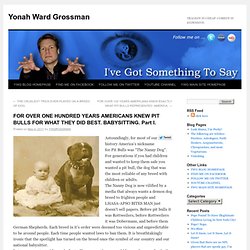

Dog Training. Dog IQ Test. (adapted from The Intelligence of Dogs by Stanley Cohen) Test 1 - Problem Solving Place treat under soup can.

Scoring: 5 Dog gets treat in 0-5 seconds 4 Dog gets treat in 5-15 seconds 3 Dog gets treat in 16-30 seconds 2 Dog gets treat in 31-60 seconds 1 Dog tries to get treat and fails 0 Dog shows no interest Test 2 - Problem Solving Quickly throw a large towel over the dog's head and shoulders. 5 Dog gets free in 0-15 seconds 4 Dog gets free in 16-30 seconds 3 Dog gets free in 31-60 seconds 2 Dog gets free in 1-2 minutes 1 Dog doesn't get free within 2 minutes Test 3 - Problem Solving Place treat under a small towel. 5 Dog gets treat in 0-15 seconds 4 Dog gets treat in 16-30 seconds 3 Dog gets treat in 31-60 seconds 2 Dog gets treat in 1-2 minutes Test 4 - Short Term Memory Let the dog see you place a biscuit in the corner of the ring, then turn him loose.
FOR OVER ONE HUNDRED YEARS AMERICANS KNEW PIT BULLS FOR WHAT THEY DID BEST. BABYSITTING. Astoundingly, for most of our history America’s nickname for Pit Bulls was “The Nanny Dog”.

For generations if you had children and wanted to keep them safe you wanted a pit bull, the dog that was the most reliable of any breed with children or adults. The Nanny Dog is now vilified by a media that always wants a demon dog breed to frighten people and LHASA-APSO BITES MAN just doesn’t sell papers.
Before pit bulls it was Rottweilers, before Rottweilers it was Dobermans, and before them German Shepherds. Each breed in it’s order were deemed too vicious and unpredictable to be around people. Each time people wanted laws to ban them. Part II of this post may be found at: And Part III at: Also: The Cruelest Trick Ever Played On A Breed Of For Over 100 Years Americans Knew Exactly What Pit Bulls Represented.
My Fan Club: Twelve Tips for a Well Behaved Dog. I) Start training your puppy early on. While old dogs can be taught new tricks, what's learned earliest, is often learned quickest and easiest. Moreover, the older the dog, the more bad habits will likely need to be "un-learned". When it comes to raising and training a dog, an ounce of problem prevention is certainly worth a pound of cure! 2) Train your dog gently and humanely, and whenever possible, teach him using positive, motivational methods. Keep obedience sessions upbeat so that the training process is enjoyable for all parties involved. 3) Does your dog treat you like "hired help" at home?
4) Avoid giving your dog commands that you know you cannot enforce. 5) One command should equal one response, so give your dog only one command (twice max!) 6) Avoid giving your dog combined commands which are incompatible. 7) When giving your dog a command, avoid using a loud voice. 9) Correct or, better yet, prevent the (mis)behavior, don't punish the dog. 12) Keep a lid on your anger. Dog Breed Info Center Search Results. ASPCA study: "Pretty" pups picked first. Cute counts -- but so does personalityThe ASPCA is set to release a study revealing that "physical appearance" is the most important reason pet adopters give for choosing puppies from animal shelters.

Cats, meanwhile, could rely on inner beauty; the numbers showed that "behavior with people" was the most important quality folks looked for in a feline. The ASPCA conducted the research from January to May of last year, gathering information at five shelters nationwide. Roughly 1,500 prospective pet parents answered questionnaires about their chosen pets, and how they decided that a particular animal was the one for them. The organization hopes to use their answers to make better and more frequent matches between shelter pets and people; understanding what factors go into the adoption decision is extra-handy for the front-line shelter workers, who can then supply additional information and insights about particular cats or dogs that might not be immediately evident to a first-time browser.